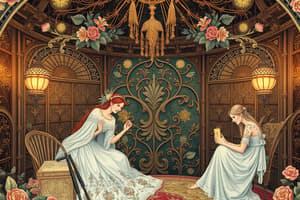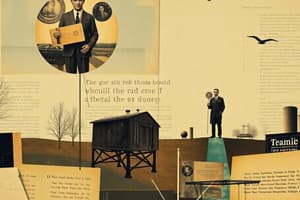Podcast
Questions and Answers
Match the literary element with its correct description:
Match the literary element with its correct description:
The main idea or lesson learned from the story. = Theme The problem or difficulty the characters face. = Conflict It tells when and where the story happens. = Setting The people or animals who take part in the story. = Characters
Match the type of figurative language with its definition:
Match the type of figurative language with its definition:
A comparison using 'like' or 'as'. = Simile Giving human qualities to non-human objects. = Personification A statement that exaggerates for emphasis. = Hyperbole A brief and indirect reference to a person, place, thing or idea of historical, cultural, literary or political significance. = Allusion
Match each narrative point of view with its description:
Match each narrative point of view with its description:
Narrator is a character in the story; uses 'I' and 'me'. = First person Narrator knows the thoughts and feelings of one character. = Third person limited Narrator knows the thoughts and feelings of all characters. = Third person omniscient Narrator is not a character and uses 'he', 'she', and 'they'. = Third person
Match the term related to poetry with its definition:
Match the term related to poetry with its definition:
Match the narrative structure element to its description:
Match the narrative structure element to its description:
Flashcards
Theme
Theme
The central idea or underlying meaning of a story; the lesson learned.
Conflict
Conflict
The struggle or challenge the characters face; it drives the story.
Setting
Setting
The time and place where the story occurs; the background.
Characters
Characters
Signup and view all the flashcards
Plot
Plot
Signup and view all the flashcards
Study Notes
- A story's central message or moral is known as the theme.
- Conflict refers to the challenges or struggles encountered by characters.
- Setting establishes the time and place in which a story unfolds.
- Characters are the individuals, animals, or entities that animate a narrative.
- Plot refers to the arrangement of events within a story, serving as its roadmap.
Studying That Suits You
Use AI to generate personalized quizzes and flashcards to suit your learning preferences.
Description
Explore the fundamental elements of storytelling. This includes understanding theme, conflict, setting, characters, and plot. These components contribute to the structure and meaning of a narrative.




